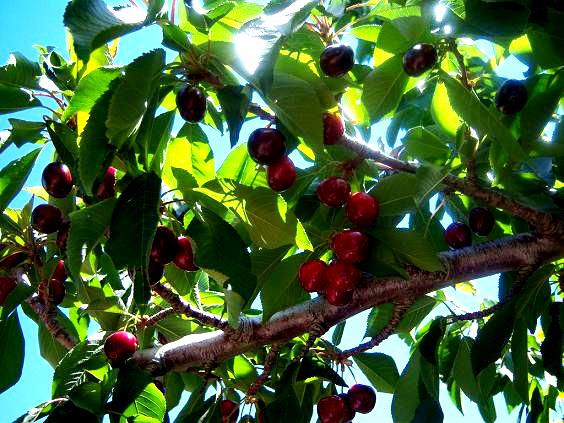 CHERRY
CHERRY
Cherries have similar soil requirements to pear trees. Cherries grow strongly on clay and clay soils, but they freeze easily and succumb to gum disease and other diseases. They cannot stand moist soils, as well as too dry and acidified.
The type of cherry has a common Latin name with cherry – Cerasus. Only one wild species belongs to this genus – Bird cherry, which grows up to height 30 m. All noble varieties and many ornamental forms have been derived from this cherry. Trees of noble cherry varieties usually grow up to large sizes, therefore, they are not recommended for planting in small gardens. Regulations of the Employee Allotment Garden are provided in, that cherries should be planted at a distance 5 m from the plot border.
The guidelines of the National Council of the Polish Allotment Association for the development and modernization of plots in permanent employee allotment gardens do not recommend cultivation on the plot of cherries, because one tree covers an area of approx 100 m2, so approx 1/3 plots. The shape of the cherry crown can be spherical or ovoid. Most of the trees live 25-30 lat, and under favorable conditions, longer. They usually start growing earlier than cherries. Cherries start fruiting early and usually bear fruit regularly, annually. Noble cherries are generally not very resistant to frost and diseases. The soil and climatic requirements of sweet cherries are quite high, generally similar to pears. It works best in warm positions and soils, fertile and with regulated water relations. Depending on the characteristics of the fruit, the noble varieties of cherries are divided into two groups: about soft fruits, the so-called. cockles and hard fruits, the so-called. cartilage, i.e. crisps.
Due to the large size of trees, at the Research Institute of Pomology and Floriculture in Skierniewice and at agricultural universities, work was undertaken to limit the growth of sweet cherries, already crowned with certain, positive results. Appropriate measures for the relative growth inhibition of sweet cherries can also be used.
And so, for example, after planting, from 3-4 year, you should bend the ends of all shoots (including a guide). We achieve a similar effect by putting a fishing net on the tree crown at the end of May. The web will crush the shoots, and thus weaken their growth, at the same time it will protect the fruit from birds. Of course, we take the net off after harvesting the fruit and store it until the next year.
In the selection of varieties for employee allotment and home gardens, three varieties are recommended: Rivan (disambiguation), In Biittnera Czerwona.
Rivan is a new Swedish variety. Creates a regular crown, spherical, quite loose, with stiff, raised branches. The fruiting period enters early, usually in 5 one year after planting. It bears fruit abundantly, almost annually. Sufficiently resistant to frost and not very susceptible to diseases. It produces medium-sized or large fruit, 4,2-5,2 g, regular, heart-shaped. Dark red or dark cherry skin, almost black, shining, Tight. The front side of the fruit is clearly convex, with a fairly wide furrow, sharply cutting into the seam line, especially in the pedunculate part. The tip of the fruit is sharp, with a post mark placed on the surface, peak. Dark red flesh with lighter veins, slightly gristly, juicy, guilty without bitterness, tasty, well off the stone. Color juice. The fruits ripen in late May or early June, evenly. They generally do not break.
Kunzego is an early variety. So far, it is relatively little widespread, despite the extremely tasty fruit, great for compotes. The tree grows very vigorously. Creates a wide conical crown, about pliable, branches growing upwards. The ends of the twigs, especially in the lower parts of the crown, hanging down. Characteristic leaves – narrow and elongated, slightly canoe-shaped along the main nerve, rarely, deep, sharply, double serrated. The fruiting period enters early. It bears fruit very profusely, when producing medium-sized or large fruit, 4,5-5 g, blunt heart-shaped. Average dimensions 20-22X5-19 mm. Light yellow skin, covered with a carmine blush, through which lighter dots and dashes show, shining, thin, elastic. Light yellow flesh, quite accurate, very juicy, sweet, delicately aromatic, very well detached from the stone. Colorless juice. The fruits usually ripen in the last decade of June, evenly. They turn red if left on the tree longer, they become more beautiful and tastier. The variety is sufficiently resistant to frost and resistant to bacterial cancer.
The Red Buttnera is the latest of these three varieties, also known as Spanish Stripe. The tree grows very vigorously. Creates a crown that is initially wide conical, spherical over the years, flattened, wide area, with slightly hanging branches. It starts bearing fruit quite late. It bears fruit very profusely, regularly. It is sufficiently resistant to frost and not very susceptible to bacterial cancer. It produces large or very large fruit, 6-9 g, typically heart-shaped, with a sharp tip. Yellow skin, shining, covered with extensive, red-brown, spotted and striped blush, when the fruit is fully ripe, it is dark red-brown and covers the entire surface of the fruit. Yellow flesh, red at the stone, gristly, juicy, wine and sweet, slightly aromatic, no bitterness, very tasty, it comes off the stone quite well. Colorless juice. Fruits ripen mostly in the second decade of July. They do not break at all during rains.
A new perspective variety with great taste is Merton Premier. It is an English variety that begins bearing fruit early, ripening in the second half of June. It produces large fruit, brown-black in color. Because trials are still underway on this variety, it is not widely known. It has nice fruit and is very hardy to frost.